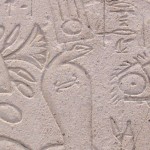
Meretseger: She Who Loves Silence. The Cobra Deity at Deir el-Medina
In the Western world the cobra rarely inspires sentiments of benevolence, warmth or good intentions. It is not a cuddly beast. Matters were more ambivalent in ancient Egypt where a range of wild animals were identified with deities imbued with admired values of physical strength, protection and courage, as well as less obviously admirable qualities like aggression, retribution, vengeance and retaliation. Like Sobek, the crocodile deity, and Sekhmet the lioness, the cobra deities comprised a mixture of attributes that centred on their fierce ability to defend themselves and to strike, hissing and spitting poison, to annihilate their aggressors. [more…]
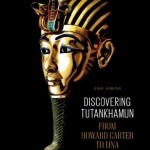
Book Review: “Discovering Tutankhamun – From Howard Carter to DNA” by Zahi Hawass
It is now some while since Zahi Hawass was finally ousted from office as Secretary General of the Supreme Council of Antiquities, following the fall of the Mubarak government in 2011; but his absolute ubiquity on TV programmes concerning ancient Egypt prior to that date (and the fact that these are repeated endlessly on various satellite/cable and terrestrial channels) means that there is little chance of any reader being unaware of his ebullient and bombastic presence. That presence is now reduced to occasional lectures about his former exploits, and adding to the series of published books that bear his name – of which this is the latest. [more…]
Edition - March, 2014
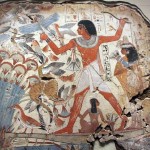
The paintings from the lost tomb-chapel of Nebamun
The paintings from the tomb of Nebamun are justifiably famous for their beauty and incredible dynamism. The British Museum purchased the panels that it has in 1821 . They were located by a Greek tomb robber named Giovanni d’Athanasi, who worked as an agent for Henry Salt in Luxor. Unfortunately d’Athanasi was angered by the finder’s fee offered and he refused to give up the location of the tomb from where the panels had been removed. The location of the chapel remains unknown to this day. [more…]
Edition - February, 2014
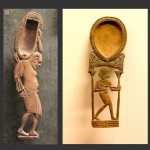
Ancient Egyptian Cosmetic Spoons of the New Kingdom
I was in the Louvre in Paris recently and was impressed by the exhibit of cosmetic spoons, so beautifully carved and so sinuously expressive. Although they are usually referred to as cosmetic, ointment or unguent spoons, their function has never been definitively established and they come in a variety of forms. This short article is a brief introduction to a much wider topic. [more…]
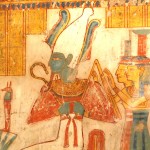
The Significance of the Crossed Arms Pose – Part 2: Osiris, The Osiris and the Osirides
Is it a futile activity to ask, as I do in this series of articles, “What is The Significance of the Crossed-Arm Pose?” It might be argued, for instance, that variations in the pose at death exhibited by royal mummies simply reflect what embalmers decided to do on the day, or at least the customary practice of a particular undertaker. Similarly, it might be argued that each individual anthropoid coffin might be expected to reveal some unique design characteristic, and that no significance should be attached to the specific hand/arm pose depicted on the lid. [more…]
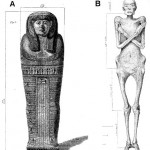
The Significance of the Crossed Arms Pose in the New Kingdom – Part 1
Amongst the many miracles through which delicate objects are preserved from ancient Egypt down into modern times, perhaps the most remarkable is the survival of the mortal remains of a virtually complete sequence of New Kingdom rulers. These kings, along with a number of queens and lesser royalty – who date from the end of the Seventeenth Dynasty through to the start of the Twenty-Second Dynasty – are generally referred to as the Royal Mummies, and were for the most part recovered from the Royal Cache of 1881 (in tomb TT320), and the Second Royal Cache of 1898 (in tomb KV35, the tomb of Amenhotep II). [more…]
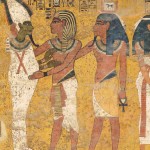
Replicating the tomb of Tutankhamun. Conservation and sustainable tourism in the Valley of the Kings
The closure of the tomb of Tutankhamun, to be replaced by an exact facsimile, has been much reported in the UK media and highlights a number of issues and raises some interesting questions. Although this is largely a discussion about the tomb of Tutankhamun, the tomb cannot be discussed in isolation and is put into the wider context of conservation issues across the royal cemeteries of the West Bank and broader globally-relevant issues of sustainable tourism. [more…]
Edition - November, 2012
Review of Tutankhamun and the Golden Age of the Pharoahs: A Souvenir Book
Published in Egyptological, In Brief, November 14th 2012. By Kate Phizackerley There is an official companion book to the exhibition and this souvenir book, a small format volume of 64 pages. At 15.5cm by 15.2cm (about 6”) it is oddly not quite square. It is easily available for one penny (or one cent) second hand […] [more…]
Solar Eclipse Events in the New Kingdom Part 2 – Astronomical Analysis
The sun played a central role in the religion and culture of Ancient Egypt. It is therefore surprising that there seems to be no unambiguous mention of solar eclipses in Ancient Egyptian texts. Eclipses would certainly have been experienced by the Ancient Egyptians and records of them would be expected to occur in the religious corpus. [more…]
Part 1 of this paper looked at the source texts and reliefs. Part 2 now sets out the astronomical background and predicts the solar eclipse events that would have occurred during the New Kingdom. These are then correlated with the New Kingdom texts and funerary material to test the hypothesis that these might record actual eclipse events. [more…]
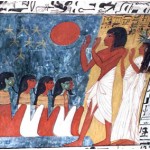
Solar Eclipse Events in the New Kingdom – Part 1: Texts and Funerary Material
This paper discusses a class of inscriptions appearing on eleven artefacts together with text and vignettes from five tombs and funerary material from Deir el-Medina, which may contain expressions made in response to eclipses. It is proposed that: [more…]
a) these artefacts record the witnessing of a deep solar eclipse; and [more…]
b) ill understood at the time, the eclipse was interpreted by witnesses as a form of punishment or omen and was consequently expressed in religious terms on stelae; protection against recurrences of the event was also included in tombs and on funerary furniture. [more…]
 By
By